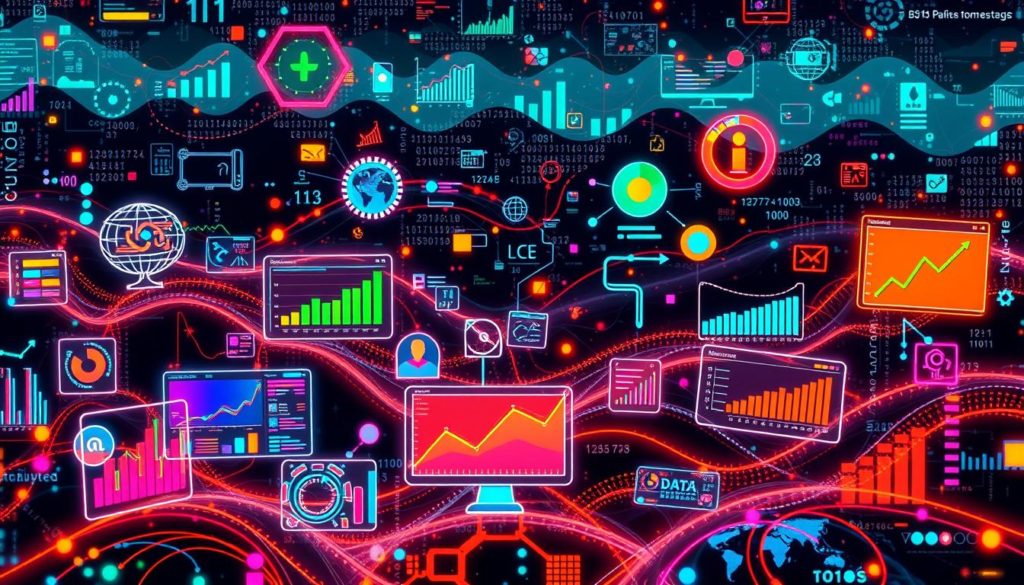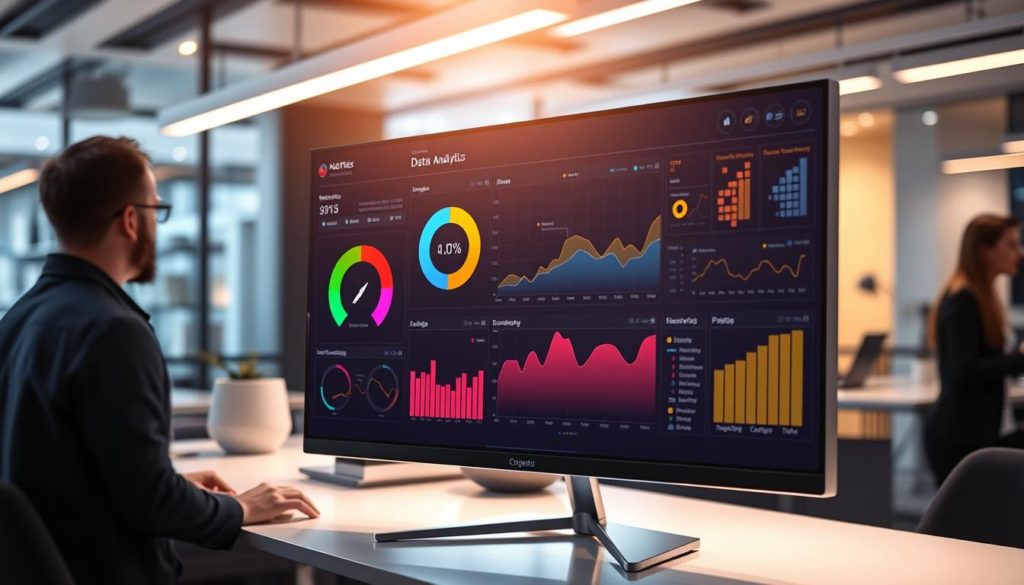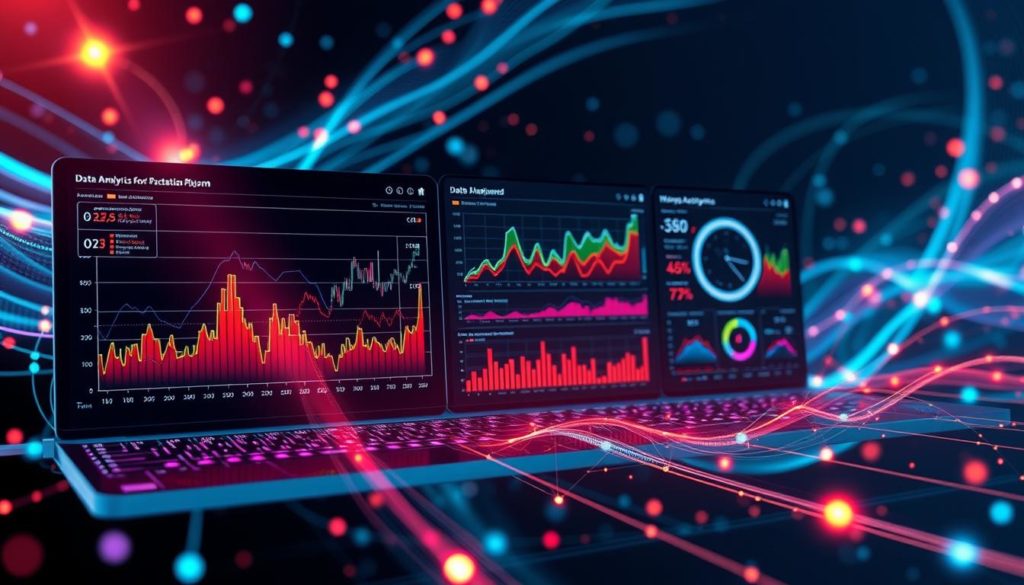
Did you know 73% of businesses plan to use more data analytics tools by the end of the year? Choosing the right data analysis software can be tough. But knowing what your business needs and what business intelligence tools can do is key to using your data well.
In today’s world, having strong data analytics tools is essential. These tools turn raw data into insights that help us make smart choices. They offer features like automated machine learning and real-time analytics. This makes them useful for both tech experts and non-tech people, helping everyone make informed decisions.
We’ll look into tools like Microsoft Power BI, SAP BusinessObjects, and Tableau. Each has special features that might be just right for your business. Gartner’s Magic Quadrant says these tools are top-notch for making complex data easy to understand and use.
When choosing tools, remember that being popular doesn’t always mean it’s the best for you. There are many great tools that don’t cost anything. They offer great features without the high price tag. For more info and comparisons, check out this detailed guide on data analysis tools.
Key Takeaways
- 73% of businesses plan to increase their use of data analytics tools this year.
- Choosing the right data analysis software is crucial for leveraging data in strategic decision-making.
- Popular business intelligence tools like Microsoft Power BI, SAP BusinessObjects, and Tableau offer varying features and functionalities.
- Many high-quality data analytics tools are available at no cost.
- It’s essential to evaluate the specific needs of your organization before selecting a data analytics tool.
The Importance of Data Analytics
In today’s world, businesses use data analytics a lot. They turn big data into useful insights. With tools like data visualization, predictive analytics, and big data analytics, companies make better decisions and plan better. This helps them improve customer experiences, find new chances, and make better products.
Benefits of Data Analytics
Data analytics has many benefits for businesses:
- Enhanced Decision-Making: Tools give precise insights, helping businesses make quick, smart choices.
- Improved Operational Efficiency: By looking at data trends, companies can make processes smoother and cut waste.
- Better Customer Experience: Predictive analytics tools help understand what customers like, making marketing more personal and boosting satisfaction.
- Risk Management: Analytics tools help spot risks and plan how to deal with them.
Types of Data Analytics
Data analytics comes in four main types, each with its own role in business:
| Type of Data Analytics | Description | Example |
|---|---|---|
| Descriptive Analytics | Looks at past data to understand what happened. | Monthly sales reports to spot trends. |
| Diagnostic Analytics | Studies data to find out why things happened in the past. | Looking into why customers left. |
| Predictive Analytics | Uses models and learning to guess what will happen next. | Forecasting sales based on trends. |
| Prescriptive Analytics | Offers advice on what actions to take based on predictions. | Advice on marketing based on customer analysis. |
Companies like Lufthansa use tools like Tableau. They use predictive and big data analytics to work better and stay ahead in their field.
Key Features to Look for in Data Analysis Software
When looking at data analysis software, focus on key features for the best performance and user happiness. Look for integration, real-time updates, and the ability to grow with your needs.
Data Integration
Good data integration is key in any strong data analysis tool. It must connect well with your current systems for complex data flows. It should work with databases, cloud services, and other apps easily. This lets companies use all their data for better decisions.
Real-time Dashboarding and Reporting
Real-time dashboards help businesses stay ahead. They should offer updates as they happen, showing important metrics right away. This helps teams work together better and react fast to new trends. Adding machine learning tools can give even more insights and predictions.
Scalability and Flexibility
As companies grow, their data needs change. So, the software must be able to grow with them without costing too much or limiting users. Being flexible lets businesses change their plans easily as needs shift. Tools for big data analytics help use large datasets for smart decisions.
| Feature | Importance | Considerations |
|---|---|---|
| Data Integration | High | Compatibility with existing systems, ease of integration |
| Real-time Dashboarding and Reporting | Critical | Instant monitoring, effective collaboration, predictive insights |
| Scalability | Essential | Support for business growth, cost-effectiveness |
| Flexibility | Vital | Adaptability, user-friendly interfaces |
Overview of the Top Data Analytics Tools
Choosing the right data analytics tools can feel like a big task, with so many options out there. We’ve highlighted some top data analysis software and business intelligence tools for 2024. This should help you make a better choice.
Microsoft Power BI
Microsoft Power BI is great for handling many data sources. It lets users make detailed dashboards and reports. It’s a top pick for those needing versatile data mining software. Plus, it works well with other Microsoft products, making it handy for users already in the Microsoft ecosystem.
Data analysis software like Power BI is key for businesses wanting to turn data into useful insights quickly.
SAP BusinessObjects
SAP BusinessObjects suits users with different levels of tech skills, making it a flexible choice for any business size. It works well with Microsoft Office, making analysis and reporting easier. It’s perfect for companies needing strong data mining and deep analysis tools.
Its ability to manage complex reports and various data sources puts SAP BusinessObjects among the top business intelligence tools.
Tableau
Tableau leads in data visualization. It works on-premises or in the cloud, offering an easy-to-use interface. Users can make interactive, colorful visuals without needing a lot of tech knowledge. However, it might struggle with complex SQL queries.
Tableau’s VizQL technology boosts performance, making it a great choice for those focused on visual data.
Each tool has its own benefits and should match your specific data analytics needs, user skill level, and integration needs. For a full guide to the best data analytics software out there, check out this detailed overview.
Choosing the Right Data Analytics Tools for Your Business
Finding the right data analytics tool means knowing what your business needs. This includes the data volume, the skills of those who will use it, and your budget. When looking at data analytics platforms, it’s key to consider their strengths and weaknesses together.
Predictive analytics tools are vital for businesses wanting to predict future trends and metrics. They should be easy to use but also have powerful features for all users. It’s also smart to choose tools that grow with your business to keep them useful over time.
Look for solutions that work well with your current systems and have strong data visualization tools. These tools make data easier to understand and help people make quick, informed decisions. Choosing tools that match your business goals makes the investment clear.
Here’s a quick guide to help you pick predictive analytics tools, data visualization tools, and full data analytics platforms:
| Criteria | Predictive Analytics Tools | Data Visualization Tools | Data Analytics Platforms |
|---|---|---|---|
| Core Function | Forecasting future trends | Graphical representation of data | Comprehensive data analysis |
| User Expertise | Data Scientists | Business Analysts | Mixed (Beginner to Expert) |
| Integration | Advanced APIs | Plug-and-play | Seamless integration |
| Cost | High | Moderate | Variable |
| Best for | Predictive insights | Data reporting | Overall data strategy |
Data Visualization in Data Analytics
Data visualization is key in data analytics. It makes complex data easy to understand by turning it into visuals. With tools like data analytics software and business intelligence tools, companies can make raw data into insights. These insights help in making better decisions.
Types of Visualizations
There are many types of visualizations, each good for different kinds of data and insights. Some top data visualization tools are:
- Charts
- Graphs
- Dashboards
Best Practices for Data Visualization
Good data visualization follows certain principles for clarity and impact. Here are some best practices:
- Simplicity: Keep it simple to avoid overwhelming the viewer.
- Accuracy: Show the data accurately to keep it trustworthy.
- Design: Use design elements that make the data easy to understand.
Tools like Tableau and Microsoft Power BI are great for making visual stories that everyone gets. These platforms are part of modern business intelligence tools. They help us find deeper insights with easy-to-use visualization techniques.
Conclusion
Using the right data analysis software can change how we get insights from our data. We’ve seen that tools like Microsoft Power BI, SAP BusinessObjects, and Tableau are key for businesses. They help us stay ahead in a tough market.
Good data integration makes sure all info moves smoothly between systems. This gives us a full view that helps us make fast decisions. With top data visualization tools, turning complex data into simple insights is easy. This lets teams spot trends and make smart choices quickly.
The journey to pick the best data analytics tools doesn’t stop. Technology keeps changing, so we must keep up with new platforms. We need to make sure our tools meet our current needs and our future goals. This way, we can keep growing, innovating, and doing great in our work.
FAQ
What are the primary benefits of using data analytics tools?
Data analytics tools turn raw data into useful insights. This helps in making better decisions, improving products, and enhancing customer experiences. They also help in quality control.
What types of data analytics are there?
There are four main types of data analytics: descriptive, diagnostic, predictive, and prescriptive. Each type helps in understanding past data, finding out why trends happen, predicting future trends, and suggesting actions.
What key features should we look for in data analysis software?
Look for features like effective data integration and real-time dashboards. Also, scalability, flexibility, and an easy-to-use interface are key. They should help both tech experts and non-tech users.
How do data visualization tools enhance data analysis?
Data visualization tools make complex data easy to see through charts, graphs, and dashboards. This makes it simpler to spot patterns and share insights with others.
Why is real-time dashboarding important for businesses?
Real-time dashboarding lets businesses track key performance metrics instantly. This helps in making quick decisions and improving operations across departments.
What are some popular data analytics tools available in the market?
Popular tools include Microsoft Power BI, SAP BusinessObjects, and Tableau. They offer various features like broad data support, detailed dashboards, and advanced visualization.
How does Microsoft Power BI stand out as a data analysis tool?
Microsoft Power BI supports a wide range of data sources. It lets users create detailed dashboards and reports. This makes it a versatile choice for different business needs.
What makes SAP BusinessObjects a good choice for data analytics?
SAP BusinessObjects suits users with different skill levels. It works well with Microsoft Office, making it a flexible option for detailed data analysis.
Can you explain the importance of scalability in data analytics tools?
Scalability means your analytics tool can grow with your business. It should handle more data without limiting users or costing more. This makes it a lasting solution for your evolving needs.
What are some best practices for data visualization?
For data visualization, keep it simple and accurate. Make sure your visuals clearly tell the data story. This helps everyone understand the data easily.
How can predictive analytics tools benefit our business?
Predictive analytics tools use past data to predict future trends. This helps businesses plan ahead, improve strategies, and make smart decisions early on.
What should we consider when choosing the right data analytics tool for our business?
Think about the data volume and type, user skills, budget, and integration needs. Also, consider if the tool is easy to use yet offers advanced features.
Why is data integration crucial for data analysis software?
Data integration is key for combining data from different sources. This creates detailed pipelines and gives full insights for better decision-making.
Future App Studios is an award-winning software development & outsourcing company. Our team of experts is ready to craft the solution your company needs.










